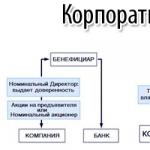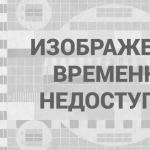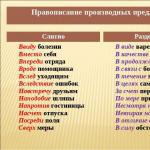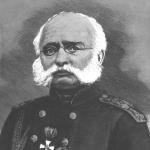Hello site readers! Many people know the catchphrase “ What kind of dog is this?” from the film “Ivan Vasilyevich changes his profession.”
Today we will talk about another “dog” - the computer symbol “ @ ”, with which all Internet users are familiar with the addresses.
And indeed, it’s terribly interesting - where did such an unusual icon come from, why is it needed, why is it named so interestingly and even funny?
Often the origins of commonly used items are shrouded in fog due to long periods of time and a lack of surviving evidence and documents.

Regarding the computer dog, everything is quite well known and reliably proven.
- The symbol in the form of a capital letter “a” outlined in an open circle has been used for a long time and is still used in the field of international commerce.
- The @ sign is an abbreviation for the English phrase “ at the rate of” in payment documents with the value “ price per piece”.
- In a general accounting sense, the English “ at” can be translated as “ in account so-and-so”.
For some reason, the creators of the Internet decided to use accounting terminology when registering users in various services. This, in general, is quite logical; registration is an entry in the Accounting Book.
So it is also logical that in the fall of 1971, one of the inventors of email, Ray Samuel Tomlinson, came up with the idea of using the “@” sign to indicate the email domain in an email address.
Useful for travelers and tourists. In European countries, road signs with the “@” symbol indicate public Internet access points.
Why is the @ symbol called a dog?
There are several legends about why @ was called a dog. The following three versions look the most reliable.

- The picture above shows the logo of one of the progenitors of the modern worldwide network - Fidonet. As you can see, the nose of the sketchy pet is precisely indicated by the at symbol in a circle.
- Another version looks even more plausible. In the days before the graphical interface was invented, a popular computer game called Adventure was popular. One of the characters was a scout dog, indicated in the playing field by the @ sign.
- The third version looks far-fetched, but is still widespread. On one of the first Soviet personal computers, DVK, this symbol served as a splash screen when turned on. Allegedly, users saw a dog curled up in this squiggle. However, for such an interpretation it is necessary to have a fairly developed imagination.
How to pronounce dog icon in English and other languages
In Russian, there is a common practice to call the symbol “@” “dog” or “dog”. The email address will be announced with the following phrase.
- “Username Dog Mail (G-mail, Yandex) Tochka Ru (or Com).”
- In economics and commerce, accounting, the ligature @ is pronounced and described traditionally as “commercial Et” or “commercial at”.
It is noteworthy that American engineers, who have shown themselves to be real masters in inventing various creative nicknames to denote technical terms, this time behaved surprisingly passively and indifferently.
In Anglo-Saxon computer terminology, a “dog” is called “commercial ET”, without any connection to funny pets.
Pronounced @ in English is also without any frills.
- [email protected]
- “Username This mail dot ru”
It remains to be concluded that this time national American pragmatism worked. Our overseas partners decided that commercial at quite adequately reflects the meaning of the symbol.
- “Account so-and-so, From email domain so-and-so.”
In some countries of the world @ also has cool nicknames, like ours.
- “Dog” – in the countries of the former USSR.
- “Monkey” – in Bulgarian, German, Polish.
- “Snail” – in Ukrainian, Italian.
In countries where the @ ligature was known long before the advent of computers, the old pronunciation “at” or “commercial at” remained. These include France, Spain and the UK.
How to type the @ symbol on the keyboard
There is no one-size-fits-all answer here. The problem is that there are many types of keyboards and variations of character layouts.

The picture above shows a classic keyboard with “big keys” and a traditional layout QWERTY in Latin or YTSUKEN in Cyrillic.
To enter @ on such a keyboard, you need to switch to the Latin font mode and press the key at the same time Shift and the number “ 2 ”.
What to do if there is no “dog” symbol on the keyboard?
In this case, there may be options.
- Switch to the symbol keyboard. Switching can be done using the Alt keys, asterisk “*”, or a special Smbl switch.
- On mobile devices, smartphones and tablets, there are simply a huge number of different keyboards. Some are specially designed for instant messengers and on such keyboards the dog symbol is implemented, for convenience and speed of typing addresses, as a separate key on the main layout.
- On most touch keyboards for mobile devices, the “@” sign is inserted in the same way as on external keyboards for desktop computers and laptops.
What should you do if you can’t find the @ symbol on your existing keyboard?
It happens. Then you should turn to the “Symbol Table”, access to which is in the list of “Standard Programs” of OS Windows.

Counterintuitively, the “dog” can be inserted through the “Insert” – “Symbols” menu in a text editor.
Mail email icon
The “dog” symbol is included in the officially registered trademark and brand logo.

I must say, a very successful and profitable acquisition from a marketing point of view.
- Firstly, the @ icon is quite organically associated with an email service.
- Secondly, the symbol is known to everyone and is popular, so its use as a designation for various products and services of the Mail.ru holding always attracts attention and increases the number of customers. This means business profits are growing.
All Mail.ru products are marked with a computer dog icon.
- Email service.
- Messenger Mail.ru Agent.
- Amigo browser with Mail.ru search (capital “a” without a circle).
It’s simply amazing how many interesting and even unusual things are hidden behind the usual “computer dog”.
Almost everyone who is in one way or another connected with computers uses e-mail. But few people wondered how the “@” symbol, used in an email address and popularly called a “dog,” came about.
The history of the “dog” goes back to 1971, when programmer Ray Tomlinson was working on a program for exchanging electronic messages and, to be able to send letters from one computer to another, used the “@” icon, which is not found in English names and surnames.
Meanwhile, @ is a ligature (conjunction of letters) meaning “at”. The exact origin of the symbol is not known, but one hypothesis is that it is an abbreviation for the Latin ad. The name "commercial at" comes from bills. Since the symbol was used in business, it was placed on typewriter keyboards, from where it migrated to the computer.
In Spanish, Portuguese and French, the name of the symbol comes from the word "arroba" - an old Spanish unit of weight, which was denoted by the @ sign when written.
In the USSR, this sign was unknown before the advent of computers, and received its name with the spread of a computer game, where, according to the script, the “@” symbol ran across the screen and denoted a dog. Moreover, translated from Tatar “et” means “dog”.
In different countries the symbol is read differently. Here are some examples:
In the USA - at (“the at sign.”)
In Bulgaria - klomba or maimunsko a (“monkey A”).
In the Netherlands - apenstaartje ("monkey tail").
In Italy they say "chiocciola" - snail.
In Denmark and Norway they use “snabel-a” - “snout a”.
In Taiwan - a mouse.
In Finland - cat's tail.
In Greece - “not enough pasta”.
In Hungary - worm, mite.
In Serbia - “crazy A”.
In Sweden - an elephant.
In Vietnam - "crooked A".
In Ukraine - dog, doggie, tsutsenyatko (Ukrainian - puppy)
The "@" symbol has many uses these days. In addition to email and other Internet services, the symbol is used in many programming languages.
In 2004, to facilitate the transmission of email addresses, the International Telecommunication Union introduced a Morse code for the @ symbol ( - - - ).
Comments
2009-09-16 16:24:25 - Leshchinskaya Lyudasha AleksandrovnaTo be honest, I didn’t know anything like that. very funny and interesting. in short, just super and thanks in advance for the high five
2009-11-19 22:49:21 - Alikberov SergeyEverything is much less romantic. Moreover, it is technocratic. The name of this icon was given by electronics engineers at the dawn of the Runet. A “dog” is a part of a cam mechanism which, due to its shape, very similar to this symbol, allows the axes of the mechanism to rotate only in one direction, i.e. blocks them, like a dog not allowing them to pass.
2010-01-30 10:40:12 - VasilyOak@ you, "technocrat" Alikberov. When @ was called a dog, there was no Runet yet. There was only an e-mail... You were probably still crawling under the table on foot... The most obvious thing is that at really sounds like a dog barking. Programmers of the early 90s always had this opinion.
2010-01-30 17:03:37 - Andrey BuninAlikberov Sergey, how about proving it?
2010-02-03 21:52:57 - Alikberov SergeyVasyatka, read what it says: “... part of a mechanism... similar to this icon...”. Have you seen cam mechanisms? And they, by the way, controlled the first Soviet ballistic missiles, representing a very reliable and noise-resistant unit. Oh, and you can still hear dogs barking...
2010-04-18 17:50:09 - Maslennikova InnaTell me how to do it so that the computer shows this dog, otherwise it doesn’t write... thanks in advance.
2010-05-25 17:39:53 - ArinaPlease tell me HOW TO ENTER THIS DOG ONTO THE COMPUTER?
2011-03-25 19:17:27 - ArinaEverything figured out. you need to press shift+2
2011-11-21 15:13:10 - Sasha 2013-07-23 19:14:27.547251 - Nastyusha 5+thanks for the peterka
2014-11-14 20:14:28.002529 - Motkov Dmitry RomanychI'm... I'm talking about the mechanism... the cam... in the Soviet... I can't wrap my head around, rockets!!! And about the winder in the watch, your knowledge is weak? The dog in mechanics IS A COMMA, however!!!
2015-07-28 18:42:40.495166 - DARIA VOLKOVAHOW TO MAKE THIS DOG?
2015-10-22 06:19:53.824886 - Zikhor Vyacheslav Vasilievichthat's so cool
2015-11-25 19:57:44.046673 - Totikova Alina EvgenievnaWhat was the name of this game with a dog (@) in the USSR?
2017-10-02 20:01:07.131344 - Pogadaev VictorIn Indonesian language this icon is called E snail (E keong)
It is unlikely that among the Internet audience there will be a person who is unfamiliar with this @ symbol. On the web, it is used as a separator between the username and hostname in email address syntax.
Some figures in the Internet space call this symbol “one of the main pop symbols of our time, a sign of our common communication space.” Somewhat pompous, in my opinion, but the worldwide recognition of this symbol, and, as is sometimes even noted, “canonization” is evidenced by the following fact.
In February 2004, the International Telecommunication Union introduced a Morse code for the @ symbol ( - - - ) to facilitate the transmission of email addresses. The code combines the Latin letters A and C and reflects their joint graphic writing.
The search for the origins of the @ symbol takes us back at least to the 15th century, and perhaps even further, although linguists and paleographers still disagree on this issue.
Professor Giorgio Stabile put forward this hypothesis. A 16th-century document written by a Florentine merchant mentioned “the price of one A of wine” (possibly an amphora). At the same time, the letter A, according to the then tradition, was decorated with a curl and looked like @.
American scientist Berthold Ullman suggested that the @ sign was invented by medieval monks to shorten the Latin word “ad”, which was often used as a universal word meaning “on”, “in”, “in relation to”, etc. In the font that the monks used, the letter “d” was written with a small tail, and this made it look a little like the number “6” in a mirror image. So the preposition “ad” became the @ symbol.
Be that as it may, this innovation was soon adopted by traders: one of the first to use the symbol outside the walls of the monastery was the Florentine merchant Francesco Lapi, who in one of his letters designated an amphora as a “dog” - a standard measure of volume in those days, approximately equal to 26 -ty l.
In Spanish, Portuguese, and French, the name of the symbol comes from the word “arroba” - an old Spanish measure of weight, ca. 15 kg. (according to other sources 11.502 kg), which is abbreviated in writing as the @ sign.
As for the Renaissance, the @ sign began to be used to indicate price, but during the Industrial Revolution, the @ sign began to appear in accountants' reports. The modern official name of the symbol "commercial at" takes its origin from bills, for example, 7 widgets @ $2 each = $14, which translates to 7 pieces. 2$ = 14$. Since this symbol was used in business, it was placed on typewriter keyboards and from there migrated to the computer.
We owe the spread of this symbol across the Internet to the forefather of email, Tomlinson. He was the same person who chose the @ symbol.
Here we need to digress a little and enlighten you on what Tomlinson was doing and why he is considered to be the inventor of email, and at the same time the @ icon, although in fact, he did neither one nor the other. The company Tomltonson worked for became involved in the ARPANet project, a computer network for the US Department of Defense, around the late 60s. It was this network that was the predecessor of the Internet. In those years, there were already several programs that were capable of transferring a file or message from one person to another. But the sender and recipient needed to use the same computer. As for the modem, even the fastest one at that time worked about 200 times slower than a modern modem, which allows you to download information at a speed of 56.6 Kbps.
Tomlinson was at that time developing an email program and creating a virtual mailbox. In fact, the email box of that time was a file that differed from the usual one only in one feature - users did not have the opportunity to correct the sent text, but only add something of their own. In such an operation, only two programs were used - SNDMSG to send the file and READMAIL to read it.
Tomlinson wrote a new program, which consisted of 200 lines of code. This program was a cross between the two above-mentioned programs and the CPYNET protocol, which was used in ARPANet to send files to a remote computer. Tomlinson's first experimental message was sent from one computer in the laboratory to another.
In order to send the file, Tomlinson spent about six months until he was able to edit the message to a computer that could actually be considered deleted.
Of course, not many people knew about Tomlinson’s success, only a circle of colleagues, since the merit was not highlighted anywhere.
Well, now we can return to the “dog”. Tomlinson used a 33 Teletype keyboard. And one day he needed a rather unique symbol that had not been widely used before. Such a character should not appear in any title or name, and it should also separate the user name and computer name. There should have been an algorithm based on the type of name - symbol - place.
In addition to numbers and letters, the keyboard had punctuation marks, as well as @. But after 1971, the keyboard model underwent changes.
@ was the simplest solution to this algorithm. As Tomlinson himself stated, this was the only option. When asked much later why he chose this particular icon, he replied simply: “I was looking for a character on the keyboard that could not appear in any name and cause confusion.”
Clickable
In 1963, the ASCII standard encoding appeared, among the 95 printed characters of which there was also a “dog”, and in 1973, members of the Internet Engineering Taskforce organization consolidated the use of the sign when separating a name and a domain - this idea in 1971 - put forward by programmer Ray Tomlinson.
Tomlinson needed such a symbol during the period when he was working on creating a messaging system on the Arpanet network (the ancestor of the Internet). Essentially, he had to come up with a new addressing scheme that would identify not only the recipients, but also the computers on which their mailboxes were located. To do this, Tomlinson needed a separator, and his, in general, random choice fell on the @ sign.
The first network address was tomlinson@bbn-tenexa. The “dog” became popular in 1996, when the Hotmail service appeared.
About a year after the events described above, Vintan Cerf and Bob Kahn invented a protocol called TCP/IP. And this, too, was mentioned for a long time only in narrow circles.
In general, the history of the Internet is quite recent, all historical figures are still alive, so it would be fair to mention the people who had a hand in the creation of e-mail.
One of the creators is Douglas Engelbart (here is the history of this invention). He made a computer mouse and created the first text messaging system. After that, Tomlinson presented it in the form of an envelope with a recipient, sender and address field and the text of the letter. After this, the program was processed by Lawrence Roberts, who came up with a list of letters, reading the letter selectively and storing the information in a separate file and forwarding it.
Tomlinson, it should be noted, was quite amused by the hype that was unleashed on the 30th email.
Despite the fame that has befallen him, he comes across as an ordinary person, although he chuckles at the fact that the e-mail, according to everyone else, appeared in one day. And this was not 30 years ago. The history of the @ sign is a rather funny epic, which is also connected with the first message. There are two legends about this.
The first version of what was contained in the historic first letter was that Tomlinson typed QWERTYUIOP - that is, the entire top row of letters from left to right. Journalists made a lot of noise about this. They were interested in what was written and clearly expected something meaningful and symbolic. Since Tomlinson was not a public person at all, he had no idea that he could say anything.
He answered quite honestly about the body of the letter, since he had no idea at all that it could turn out to be historical. But journalists need zest, not platitudes. Therefore, I didn’t really want to inform everyone that the letter contained a completely disordered set of letters. That's why QWERTYUIOP appeared. But the engineer does not even think to refute this version.
And the second version is that he wrote a quote from Lincoln's Gettysburg Address. One must think that the scientist is simply making fun of journalists and making fun of them as much as he can. It would be strange if he actually wrote something sublime in every experimental letter. But the journalists liked this version enough, and they began to repeat it.
In Russia, users most often call the “@” symbol “dog,” which is why e-mail addresses derived from personal names and surnames sometimes take on an unexpected connotation. It is curious that this symbol is used in their work by both folk talents (for example, the joke: “The dog is missing, don’t offer @”), and official jokers - KVN players (for example, “ [email protected]»).
But still: why “dog”? There are several versions of the origin of this funny name.
Firstly, the icon really does look like a curled up dog.
Secondly, the abrupt sound of the English “at” is a bit like a dog barking.
Thirdly, with a fair amount of imagination, you can see in the outline of the symbol almost all the letters included in the word “dog”, well, with the exception of “k”.
But the most romantic is the following legend: “A long time ago, when computers were large and displays were exclusively text-based, there lived a popular game with the simple name “Adventure.” Its point was to travel through a computer-generated labyrinth in search of treasures and battles with harmful underground creatures. In this case, the labyrinth on the screen was drawn with the symbols “!”, “+” and “-”, and the player, treasures and hostile monsters were designated by various letters and icons. Moreover, according to the plot, the player had a faithful assistant - a dog, who could be sent into the catacombs for reconnaissance. And it was, of course, indicated by the @ sign.”
Whether this was the root cause of the now generally accepted name, or, conversely, the icon was chosen because it was already called that way, the legend is silent about this.
To be fair, it should be noted that in Russia “dog” is also called doggie, frog, bun, ear, ram and even muck.
In other countries, this symbol is associated with various objects. Below is a far from complete list of how the “@” symbol is called in other countries.
Italians say “chiocciola” (“snail”), in Greece they know it as “παπακι” - “duck”, in the Czech Republic and Slovakia - “zavináč” - rollmops - (“herring roll” or marinated herring), in Taiwan they use the concept “小老鼠” (pronounced “xiao lao shu”) - “mouse”, in Israel the common name is “שטרודל” - “strudel”, and in Kazakhstan the sign is called “aikulak” - “ear of the moon”.
Bulgaria – klomba or maimunsko a (“monkey A”),
Netherlands – apenstaartje (“monkey tail”),
Spain – like the weight measure “arroba”,
France – the same weight unit “arrobase”,
Germany, Poland – monkey tail, monkey ear, paper clip, monkey,
Denmark, Norway, Sweden - “snabel-a” - “snout a” or elephant trunk,
America, Finland - cat,
China, Taiwan - little mouse,
Türkiye - rose,
in Serbia - “crazy A”,
in Vietnam – “crooked A”,
in Ukraine - “ravlik” (snail), “doggie” or again “dog”.
As you can see, for many peoples the @ sign evokes an association with a comfortably nestled animal, for some with a delicious strudel or herring roll, the poetic Turks compared it to a flower, but the disciplined Japanese use the English “attomark” without any poetic comparisons.
sources
http://www.factroom.ru/facts/40864#more-40864
http://shkolazhizni.ru/archive/0/n-7999/
http://viva-woman.ru/novosti-so-vsego-sveta/kak-pojavilsja-simvol-sobaka.html
On the web, it is used as a separator between the username and hostname in email address syntax.
Some figures in the Internet space call this symbol “one of the main pop symbols of our time, a sign of our common communication space.” Somewhat pompous, in my opinion, but the worldwide recognition of this symbol, and, as is sometimes even noted, “canonization” is evidenced by the following fact. In February 2004, the International Telecommunication Union introduced a Morse code for the @ symbol (. - - . - .) to facilitate the transmission of email addresses. The code combines the Latin letters A and C and reflects their joint graphic writing.
The search for the origins of the @ symbol takes us back at least to the 15th century, and perhaps even further, although linguists and paleographers still disagree on this issue.
Professor Giorgio Stabile put forward this hypothesis. A 16th-century document written by a Florentine merchant mentioned “the price of one A of wine” (possibly an amphora). At the same time, the letter A, according to the then tradition, was decorated with a curl and looked like @. American scientist Berthold Ullman suggested that the @ sign was invented by medieval monks to shorten the Latin word “ad”, which was often used as a universal word meaning “on”, “in”, “in relation to”, etc. In Spanish, Portuguese, and French, the name of the symbol comes from the word “arroba” - an old Spanish measure of weight, ca. 15 kg., which is abbreviated in writing as the @ sign.
The modern official name of the symbol "commercial at" takes its origin from bills, for example, 7 widgets @ $2 each = $14, which translates to 7 pieces. 2$ = 14$. Since this symbol was used in business, it was placed on typewriter keyboards and from there migrated to the computer.
We owe the spread of this symbol across the Internet to the forefather of email, Tomlinson. He was the same person who chose the @ symbol. When asked much later why he chose this particular icon, he replied simply: “I was looking for a character on the keyboard that could not appear in any name and cause confusion.”
Tomlinson needed such a symbol during the period when he was working on creating a messaging system on the Arpanet network (the ancestor of the Internet). Essentially, he had to come up with a new addressing scheme that would identify not only the recipients, but also the computers on which their mailboxes were located. To do this, Tomlinson needed a separator, and his, in general, random choice fell on the @ sign. The first network address was tomlinson@bbn-tenexa.
In Russia, users most often call the “@” symbol “dog,” which is why e-mail addresses derived from personal names and surnames sometimes take on an unexpected connotation. It is curious that this symbol is used in their work by both folk talents (for example, the joke: “The dog is missing, don’t offer @”), and official jokers - KVN players (for example, “ [email protected]"). But still: why “dog”?
There are several versions of the origin of this funny name.
Firstly, the icon really does look like a curled up dog.
Secondly, the abrupt sound of the English “at” is a bit like a dog barking.
Thirdly, with a fair amount of imagination, you can see in the outline of the symbol almost all the letters included in the word “dog”, well, with the exception of “k”.
But the most romantic is the following legend: “A long time ago, when computers were large and displays were exclusively text-based, there lived a popular game with the simple name “Adventure.” Its point was to travel through a computer-generated labyrinth in search of treasures and battles with harmful underground creatures. In this case, the labyrinth on the screen was drawn with the symbols “!”, “+” and “-”, and the player, treasures and hostile monsters were designated by various letters and icons. Moreover, according to the plot, the player had a faithful assistant - a dog, who could be sent into the catacombs for reconnaissance. And it was, of course, indicated by the @ sign.”
Whether this was the root cause of the now generally accepted name, or, on the contrary, the icon was chosen because it was already called that way - the legend is silent about this.

To be fair, it should be noted that in Russia “dog” is also called doggie, frog, bun, ear, ram and even muck. In other countries, this symbol is associated with various objects.
Below is a far from complete list of how the “@” symbol is called in other countries.
- Bulgaria - "klomba" or "maymunsko a" (monkey A)
- Netherlands - "apenstartje" (monkey tail)
- Israel - "strudel" (swirl)
- Spain, France, Portugal - "arroba", "arrobase" (measure of weight)
- Germany - monkey tail, monkey ear, monkey, paper clip
- Italy - chiocciola" (snail)
- Denmark, Norway, Sweden - “snabel-a” (snout a) or elephant trunk (a with trunk)
- Czech Republic, Slovakia - rollmops (marinated herring)
- America is a cat
- China, Taiwan - mouse
- Türkiye - rosette
- Serbia - “crazy a” or maimun (monkey)
- Vietnam - "crooked a"
- Ukraine - “ravlik” (snail), “doggie” or “doggie”, “mavpochka” (monkey)
- Poland, Croatia, Romania, Slovenia, Holland - "malpa" (monkey)
- Finland - cat's tail
- Greece - not enough pasta
- Hungary - worm, mite
- Latvia - "et"
- Russia - besides the dog - a dog, a frog, a bun, an ear and a quack.
As you can see, for many peoples the @ sign evokes an association with a comfortably nestled animal, for some with a delicious strudel or herring roll, the poetic Turks compared it to a flower, but the disciplined Japanese use the English “attomark” without any poetic comparisons.
Today we have a “dog” icon on our turn, which, if we adhere to a scientific approach, is officially called “commercial at”, it looks something like this: @. Sound familiar? Well, a dog, an “incomprehensible badge”, “with a tail” and even a “monkey”. But mostly it’s “dog”. Why and where did this name come from? Many are perplexed, but still continue to say something like “Petrovinvest dog mail.ru” when dictating (for example, their Email on the phone). It doesn't always turn out well.
Moreover, at the other end of the line he will most likely be understood correctly, if he is not a foreigner or a Russian-speaking comrade who has been living in a foreign land for a long time. For the latter, “dog” (especially if this word is translated into the opponent’s language) causes stupor. The fact is that this designation took root only in RuNet, and in the bourgeoisie they don’t call the @ symbol, but not like us. By the way, the history of the appearance of this icon both on the keyboard and in email addresses is also interesting. Actually, this is what we will talk about in this post.
How to correctly pronounce the @ sign - dog, dog or...
So, in 99.9 percent of cases, our compatriots are forced to “distinguish themselves” in the process of verbal transmission to someone. Despite the dominance of instant messengers, regular email. mail is still the de facto main contact channel (at least the official one). Most often, emails are exchanged when there is a need to contact or receive some materials (photos, documents, etc.).
It’s good if you have the opportunity to write “your soap” to your opponent on a piece of paper or send it in an SMS message. The problem with the “dog” comes up precisely when it is necessary to transmit email by voice. It’s not a problem to convey Latin characters using names (by the first letters), but the @ icon not only confuses many people, but also makes them wonder whether it would be correct to call it a “dog” (like a dirty word). And why exactly “sobakevich”?
So, first things first. Yes, calling the @ icon a dog is perfectly acceptable(at least on television and in the press they do not shy away from this jargon, although they can hardly serve as examples of correct behavior and expression of one’s thoughts). However, it would be better to still understand what is being said, and if yours doesn’t understand you, then quickly correct yourself and give another (officially correct, not slang) sound designation for the @ symbol.
Actually, it's pronounced "eth"(from English at). This sign is written as "commercial at". Why commercial? Well, because the English word at itself is a preposition, which has several translation variations in the Russian language (meanings - the Russian language is great and powerful). For example, it can be the preposition "on", "by" or "in" (sometimes "about"), but in general it is usually indicates location.
By the way, this is why its symbolic designation (the @ icon) was chosen to display Email addresses. Look how everything falls into place..ru”, i.e.. But I’m getting a little ahead of myself. We had a question - why “@” is called the commercial at. Here again everything is quite logical.
To abbreviate in English accounts (accounting documentation), several hundred years ago it became customary to write a single @ symbol instead of the word at. For example, like this: 7 articles @ 5 thousand rubles = 35 thousand rubles. If you decipher it, it will turn out: writing seven articles “at” 5 thousand rubles apiece will cost 35 thousand rubles. Thus, the question of why @ is called a commercial at can be considered over. Go ahead.
Because accounts (accounting) is a serious matter, then with the advent of the first serial typewriters, in addition to the usual letters and numbers, they began to add the “dog” sign (in their name). Well, because... Since personal computers largely inherited their layout from typewriters, the @ symbol has successfully migrated to the keyboards of PC users. So we followed it pretty clearly.
But why was “dog” (et) chosen as ? Well, it’s worth mentioning here that @ is used as a separator not only in email addresses, but also in . It is used to separate the login and password from the actual address of the page being accessed (see the link for details). But this format of URLs is rare, and for the vast majority of Internet users the stumbling block is located in the email address.
As I already (hurriedly) mentioned a little higher, adding the “at” sign as a separator was quite logical (based on the meaning of the word at and the use of its analogue in the form of the @ symbol in bourgeois accounting). Those. any email address can be easily pronounce as: petrov on gmai.com (and this will be extremely correct and true).
Everything is clear and no questions arise with dogs. If you dive into history once again, the first to introduce this type of recording into use was a certain Tomlinson (a programmer, of course) back in the shaggy year of 1971. With the help of this record, the host (computer, server) on which this user had to be searched was also separated.
With a Russian-language keyboard layout, in order to insert the @ icon into the text, you will first need to switch to English using hotkeys (depending on the OS settings, this can be done with the key combination Shift+Alt or Shift+Control), or by clicking by the language selection icon in the tray (bottom right area of the screen). @ lives above the number 2, i.e. To insert it, you will need to hold Shift and press two (for those new to using PCs, I’ll chew).
So why is the @ symbol called a dog in RuNet?
Naturally, at that time in the vastness of the RuNet (which did not yet exist) no one knew about this. The initial computerization of the majority of the Russian-speaking mass of users began only in the 80s, and it was then that the jargon “dog” (dog) appeared to denote the sign separating the writing of an email address. Email mail in general was one of the first aspects that a novice PC and Internet user became acquainted with ().
There is no exact information about who or what prompted the viral spread of this meme (Internet jargon). There are several assumptions, and all of them are rightly based on the fact that in the 80s there was no graphics we were used to - neither in games nor in operating systems. Everything was test, or rather symbolic.
For example, in games, characters were displayed and locations were created using various icons. I still remember the flying shooter game that I spent money on in an online club during my childhood - everything there was drawn with arrows, sticks and stars. But what a thrill I felt from the game then! It is no longer possible to understand, repeat or explain this now (one can only remember it with longing).
So, there is several versions explaining the assignment of the name “dog” to the @ icon or “doggy” (probably ladies use this option more often). According to one of them, it was the action-adventure game that was popular at that time that served as the starting point for the viral spread of the meme (personally, I did not play it, or I completely forgot). In it, a dog traveled with the hero, which was either entirely or partially (its nose) displayed using the @ symbol. In this case, the association is quite understandable and explainable.
According to another version, the special spelling of the @ sign on some popular computers in RuNet at that time is to blame. This sign was drawn with a shortened tail and very much resembled a dog.

In addition, it was always displayed when loading, and once a name mentioned by someone could find support and begin to spread virally so much as to break through the gap of generations, completely losing its original meaning.
What's the result?
In general, there is only one conclusion - the @ symbol is called a dog for a reason that has long been unclear to us. This is just a rudiment - everyone talks and I talk. Is it worth continuing this bacchanalia? Why not. This makes Russian-speaking netizens even more mysterious in the eyes of foreigners.
Although they themselves do not lag behind and often instead of the English “et” they pronounce something like “snail” (indeed, the @ sign looks like a snail - certainly more than like a dog), “monkey”, “and with a tail” (trunk , curl), “duck”, “bun”, etc. (I would also add the statement “some crap” by Voronin Sr. from the series, because it also fits). People's imagination is limitless.
P.S. By the way, I want to correct myself. “Dog” (aka “et”) found registration not only in email addresses. We can say that it has successfully gained a foothold there too. After all, the @ icon is always placed before the user’s name, for example, when replying to his message.
Good luck to you! See you soon on the pages of the blog site
You might be interested
What is synthesis and how does it differ from analysis?  Emoticons on Twitter - how to insert them and where you can copy pictures of emoticons for Twitter What is a friend zone and how to know that you are in it - 4 steps to properly exit the friend zone
Emoticons on Twitter - how to insert them and where you can copy pictures of emoticons for Twitter What is a friend zone and how to know that you are in it - 4 steps to properly exit the friend zone  Hidden emoticons in Skype - where to get new and secret emoticons for Skype Who is a person: theories of origin, differences from animals and needs What is generosity and how to develop this quality in yourself
Hidden emoticons in Skype - where to get new and secret emoticons for Skype Who is a person: theories of origin, differences from animals and needs What is generosity and how to develop this quality in yourself  Create an email - what is it, how and where to register and which email to choose (mailbox) What is cognition - types, forms, methods and levels of cognition Why VK won’t load and the browser won’t log into VKontakte What are epithets and what they are like (using examples from literature)
Create an email - what is it, how and where to register and which email to choose (mailbox) What is cognition - types, forms, methods and levels of cognition Why VK won’t load and the browser won’t log into VKontakte What are epithets and what they are like (using examples from literature)




















